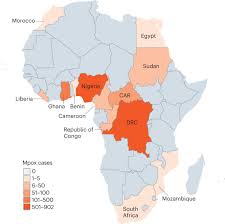Uncategorized
Mpox Outbreak Africa: Understanding the Resurgence of a Viral

The Mpox outbreak in Africa has captured international attention as health authorities scramble to contain the resurgence of this once-neglected tropical disease. Once confined largely to rural regions in Central and West Africa, Mpox (formerly known as Monkeypox) is now spreading across wider geographic areas. In this comprehensive article, we explore the causes, impact, and response to the Mpox outbreak Africa is currently facing.
What Is Mpox and Why Is It a Concern?
Mpox is a rare viral disease caused by the Mpox virus, a member of the Orthopoxvirus genus. It is closely related to the now-eradicated smallpox virus. Though Mpox is less severe than smallpox, it still poses serious public health concerns due to its potential for human-to-human transmission and significant morbidity rates.
The Mpox outbreak Africa is facing today marks a troubling resurgence, with case numbers rising in countries that historically reported few infections. Health officials are especially concerned about how the virus may evolve and spread due to environmental, social, and infrastructural challenges across the continent.
History and Origins of Mpox in Africa
The Mpox virus was first discovered in 1958 in laboratory monkeys, hence the original name “Monkeypox.” However, the first human case was identified in 1970 in the Democratic Republic of the Congo. Since then, Mpox has been endemic in several African nations, particularly in forested regions of Central and West Africa.
The current Mpox outbreak in Africa is not the first, but it is among the most widespread and alarming. Several factors such as deforestation, urban migration, wildlife trade, and climate change are contributing to the resurgence and spread of the virus into new areas.
Current Status of the Mpox Outbreak in Africa
As of 2025, multiple countries in Africa, including Nigeria, the Democratic Republic of the Congo, Cameroon, and the Central African Republic, have reported confirmed Mpox cases. The Mpox outbreak Africa is experiencing shows both zoonotic (animal-to-human) and community (human-to-human) transmission.
According to the Africa CDC, thousands of suspected and confirmed cases have been reported this year, with some countries also recording deaths. The outbreak is particularly concerning in conflict-affected and low-resource settings where healthcare infrastructure is already strained.
How Mpox Spreads Among Humans
Understanding how the virus spreads is key to controlling the Mpox outbreak Africa is facing. Mpox can be transmitted through:
-
Direct contact with bodily fluids or lesions of infected individuals
-
Contact with contaminated materials like clothing or bedding
-
Respiratory droplets during prolonged face-to-face contact
-
Zoonotic transmission through bites or scratches from infected animals, particularly rodents and primates
This transmission pattern highlights the need for improved sanitation, health education, and surveillance systems.
Symptoms and Diagnosis of Mpox
The symptoms of Mpox typically begin with:
-
Fever
-
Headache
-
Muscle aches
-
Swollen lymph nodes
-
Fatigue
Within a few days of fever onset, a rash develops—often starting on the face and then spreading to other parts of the body. The rash progresses through several stages before forming scabs and eventually healing.
Diagnosis is usually confirmed through PCR testing of lesion samples. In remote parts of Africa, where access to labs is limited, this poses a significant challenge during the ongoing Mpox outbreak Africa is battling.
Public Health Response to the Mpox Outbreak in Africa
Governments and international health agencies are implementing various strategies to control the Mpox outbreak Africa is facing:
-
Surveillance and Case Reporting: Increased disease monitoring and rapid case reporting are essential to identifying and isolating outbreaks.
-
Vaccination Campaigns: Although smallpox vaccines provide some protection against Mpox, access remains limited in many African countries. Efforts are being made to expand vaccine availability in high-risk areas.
-
Public Education: Raising awareness about transmission risks, hygiene practices, and the importance of early medical intervention is crucial.
-
International Support: WHO and Africa CDC are collaborating with regional health authorities to strengthen laboratory testing, treatment capacity, and resource mobilization.
Challenges Facing Africa During the Mpox Outbreak
The Mpox outbreak in Africa is complicated by several structural and social challenges:
-
Weak Healthcare Infrastructure: Many affected countries lack the facilities and trained personnel needed for diagnosis and treatment.
-
Stigma and Misinformation: Fear and misconceptions surrounding Mpox can prevent people from seeking help or reporting symptoms.
-
Underfunding: Global health funding often overlooks diseases considered endemic to Africa, resulting in delayed response times and limited resources.
These issues must be addressed comprehensively to bring the outbreak under control and prevent future epidemics.
Comparing the Mpox Outbreak in Africa to Global Cases
While Mpox outbreaks have now been reported globally, the situation in Africa remains unique. In other parts of the world, the virus spread primarily through close physical contact in specific social networks. In contrast, the Mpox outbreak Africa is experiencing includes both zoonotic spillover events and sustained community transmission.
This underscores the importance of developing localized strategies rather than applying one-size-fits-all solutions to epidemic response.
What Can Be Done to Prevent Future Mpox Outbreaks in Africa?
To avoid future crises like the current Mpox outbreak in Africa, public health experts suggest the following long-term solutions:
-
Stronger Surveillance Systems: Better early-warning systems can detect cases before they escalate.
-
Improved Access to Healthcare: More clinics, trained staff, and diagnostics in rural regions.
-
Research and Development: Investment in Mpox-specific vaccines and treatments.
-
Global Collaboration: Cross-border coordination and equitable distribution of medical resources.
Only a multi-layered, collaborative approach will ensure a sustainable solution to Mpox and similar infectious diseases.
Conclusion: Moving Forward From the Mpox Outbreak in Africa
The Mpox outbreak Africa is currently facing serves as a stark reminder of the need for robust healthcare systems and proactive public health measures. While challenges abound, there is hope in the form of increased awareness, scientific research, and international cooperation. By investing in prevention and preparedness today, Africa and the world can build a stronger defense against tomorrow’s pandemics
Uncategorized
Lwedninja: Everything You Need to Know About the Rising Digital

In today’s ever-changing digital world, certain terms emerge and quickly gain popularity among online communities. One such term is lwedninja. While it may seem mysterious at first glance, lwedninja represents more than just a catchy name—it embodies a concept that resonates with tech enthusiasts, gamers, and digital innovators. This article explores what lwedninja means, its origins, its uses, and why it’s generating buzz across the internet.
What is Lwedninja?
At its core, lwedninja refers to a unique digital persona or identity that blends creativity, stealth, and skill. The term is often associated with individuals or platforms that operate smartly, adapt quickly to trends, and maintain a certain level of mystery. Just like a ninja in the physical world, thrives on precision, speed, and strategic action.
Although its exact origin remains unclear, many believe started as a gaming alias or online handle before evolving into a broader concept used in different digital contexts.
The Origin of the Lwedninja Concept
The lwedninja term began appearing in niche online forums, where gamers and content creators used it to describe someone with exceptional abilities to navigate challenges without drawing unnecessary attention. Over time, it gained traction in communities that value both innovation and discretion.
Interestingly, is not tied to one specific platform—it can be a brand name, a personal identity, or even a digital project. Its flexibility is part of what makes it so appealing.
Lwedninja in the Gaming World
The gaming industry has embraced lwedninja as a symbol of strategic thinking and skillful execution. Many gamers use as their in-game nickname to convey qualities like:
-
Agility – Moving quickly and efficiently within the game.
-
Stealth – Staying unnoticed until the perfect moment to act.
-
Precision – Making every move count.
-
Adaptability – Adjusting strategies depending on the opponent or situation.
Whether in battle royale games, RPGs, or strategy simulations, the identity stands for players who combine intelligence with action.
Lwedninja in Digital Branding
Beyond gaming, lwedninja is also emerging as a unique brand identity. Entrepreneurs, marketers, and content creators are using the term to stand out in crowded online spaces. A brand built around often emphasizes:
-
Innovation – Constantly finding new ways to solve problems.
-
Secrecy – Revealing information strategically to create intrigue.
-
Consistency – Delivering quality while maintaining a recognizable style.
For businesses, adopting a approach means being flexible enough to adapt to market changes while staying true to core values.
Why Lwedninja Appeals to Modern Audiences
The rise of lwedninja is no coincidence—it reflects what today’s digital audience values. People are drawn to concepts that combine mystery with expertise, and delivers exactly that. Here’s why it works:
-
Memorability – The unusual name makes it easy to remember.
-
Versatility – It can fit gaming, branding, marketing, or personal projects.
-
Symbolism – It represents intelligence, agility, and effectiveness.
The Skills That Define a Lwedninja
A person or brand embodying the lwedninja spirit usually possesses certain skills:
-
Strategic Thinking – Planning actions carefully to achieve the best results.
-
Technical Expertise – Having deep knowledge of tools, platforms, or systems.
-
Creative Problem-Solving – Finding unique solutions to challenges.
-
Digital Agility – Quickly adapting to technological changes and trends.
These qualities allow a to excel in competitive environments.
How to Adopt the Lwedninja Mindset
If you want to embrace the lwedninja way in your own life or brand, here are some steps:
-
Stay Informed – Keep up with industry trends to act ahead of competitors.
-
Work Quietly, Win Loudly – Focus on delivering results before broadcasting them.
-
Be Adaptable – Change strategies when necessary without losing direction.
-
Prioritize Quality – Every move should be intentional and impactful.
Potential Future of Lwedninja
As digital spaces evolve, lwedninja could expand into more industries. We might see:
-
Tech startups adopting the term for innovative products.
-
Esports teams using it as a brand or mascot.
-
Marketing campaigns built around the stealth and strategy concept.
The adaptability of ensures it will remain relevant for years to come.
Final Thoughts
Lwedninja is more than just a catchy phrase—it’s a digital philosophy rooted in intelligence, adaptability, and strategic execution. Whether you’re a gamer seeking a memorable identity, a brand wanting to stand out, or simply someone who appreciates the art of subtle success, adopting the lwedni mindsetnja could be your next big move.
Uncategorized
Levapioli: Origins, Applications, and Impact in Modern Innovation

In the evolving landscape of technology and design, Levapioli has emerged as a term that captures curiosity and sparks interest across industries. Whether you are an enthusiast seeking to understand its roots or a professional exploring its potential applications, Levapioli has become a concept that blends tradition, innovation, and forward-thinking solutions. This article takes you on an in-depth journey through the meaning, uses, and relevance of Levapioli in today’s world.
Understanding Levapioli
Levapioli is a term that may appear unfamiliar at first, but its influence spans multiple areas. While the origins of are subject to interpretation, the concept represents a combination of adaptability, functionality, and unique problem-solving methods. It is often used to describe tools, systems, or ideas that provide efficient and innovative solutions to common challenges.
The modern usage of Levapioli goes beyond its literal meaning—it has become a representation of adaptability in the digital and industrial age. From creative fields to engineering, stands as a testament to the power of merging traditional approaches with contemporary advancements.
The History and Evolution of Levapioli
Tracing the origins of Levapioli reveals a fascinating blend of cultural heritage and modern ingenuity. The early references often describe it as a specialized tool or method that solves intricate problems with minimal resources. Over time, industries have adopted the concept to streamline processes, enhance creativity, and achieve better results.
In the last decade, has seen a transformation fueled by technology. Once regarded as a niche concept, it is now increasingly linked with digital transformation, smart systems, and automation. This shift reflects how adaptable and relevant has become.
Key Features of Levapioli
Levapioli is recognized for certain distinctive characteristics that make it a standout concept:
-
Efficiency – focuses on doing more with less, minimizing waste while maximizing output.
-
Adaptability – It thrives in dynamic environments, easily adjusting to new demands.
-
Innovative Design – Whether applied in technology, architecture, or creative arts, encourages fresh perspectives.
-
User-Centric Approach – Practicality and usability are central to ensuring that solutions are intuitive and accessible.
These features allow Levapioli to be embraced by multiple industries, making it more than just a passing trend.
Applications of Levapioli Across Industries
The versatility of Levapioli allows it to fit seamlessly into a wide variety of sectors:
1. Technology and Engineering
In engineering, often refers to specialized components or methods that simplify complex mechanical or digital tasks. For instance, in software development,-inspired systems focus on automation, error reduction, and intuitive user interfaces.
2. Design and Architecture
Levapioli principles have found their way into modern design practices. Whether it’s creating ergonomic furniture or sustainable housing solutions, encourages designs that balance beauty and functionality.
3. Manufacturing
In manufacturing, Levapioli emphasizes lean production, reducing waste while maintaining high-quality standards. This approach aligns well with eco-friendly initiatives and cost-efficient production models.
4. Creative Industries
Artists, writers, and content creators apply Levapioli thinking to produce unique, impactful work that resonates with audiences while using streamlined creative processes.
Why Levapioli is Gaining Popularity
Several factors contribute to the growing recognition of Levapioli in today’s professional landscape:
-
Globalization – As industries become more interconnected, adaptable solutions like are in high demand.
-
Sustainability Goals – The emphasis on eco-friendly processes aligns perfectly with’s efficiency-driven approach.
-
Technological Advancements – Emerging tech integrates seamlessly with -inspired frameworks, amplifying their impact.
Its broad adaptability ensures that remains relevant regardless of changes in market trends or consumer behavior.
How to Implement Levapioli in Your Work
Applying Levapioli principles can transform your workflow and improve results. Here are practical ways to incorporate it:
-
Identify Inefficiencies – Look for areas in your process where resources are underutilized or wasted.
-
Adopt Simplicity – Use straightforward, streamlined solutions that reduce complexity without sacrificing quality.
-
Leverage Technology – Integrate tools and systems that align with ’s focus on efficiency and adaptability.
-
Encourage Collaboration – Involve different perspectives to foster innovative problem-solving.
Future of Levapioli
The future ofappears bright, with continued growth expected as more industries recognize its value. Experts predict that artificial intelligence, automation, and sustainable design will integrate deeper with concepts, leading to groundbreaking innovations.
may also play a vital role in global sustainability projects, offering cost-effective and environmentally friendly solutions to pressing challenges. Its emphasis on doing more with less positions it perfectly for the resource-conscious world of tomorrow.
Final Thoughts on Levapioli
is more than just a term—it’s a mindset, a methodology, and a bridge between tradition and modernity. By embracing its principles, individuals and organizations can unlock new levels of creativity, efficiency, and adaptability. As industries evolve, will continue to inspire fresh approaches and practical solutions, making it a cornerstone of innovation for years to come.
Uncategorized
HCOOCH CH2 H2O: Structure, Properties, and Applications

The compound HCOOCH CH2 H2O may look complex at first glance, but understanding it is easier than it seems. This chemical formula represents an ester-like structure that includes a water molecule, which significantly influences its properties and uses. In the field of chemistry, HCOOCH CH2 H2O can be found in discussions about organic reactions, laboratory synthesis, and industrial applications. Knowing its structure, behavior, and potential uses helps students, researchers, and professionals alike.
Breaking Down the Formula HCOOCH CH2 H2O
The formula HCOOCH CH2 H2O can be split into different parts to understand its meaning:
-
HCOOCH – This portion indicates the presence of a formate ester group. Esters are organic compounds derived from acids and alcohols.
-
CH2 – This group represents a methylene unit, often acting as a linking carbon in organic molecules.
-
H2O – This shows that water is part of the compound, either as a hydrate or associated in reaction processes.
When combined, these groups create a unique chemical species with distinct reactivity compared to simple hydrocarbons or esters.Structural Representation of HCOOCH CH2 H2O
Chemists often represent HCOOCH CH2 H2O in structural formulas to visualize its atomic arrangement. A possible representation involves:
-
Carbon atoms forming the backbone of the molecule.
-
Oxygen atoms double-bonded and single-bonded to carbon, forming ester linkages.
-
Hydrogen atoms completing the valency and maintaining the molecular stability.
-
Water molecules either weakly bonded through hydrogen bonding or integrated into the crystal lattice in the case of a hydrate.
Such a structure helps predict the compound’s boiling point, melting point, and reactivity.
Physical and Chemical Properties
HCOOCH CH2 H2O exhibits several interesting physical and chemical characteristics:
-
Appearance: Can exist as a liquid or crystalline solid depending on its environment.
-
Solubility: Often soluble in polar solvents like water and alcohol due to the oxygen-containing functional groups.
-
Odor: Esters often have pleasant, fruity smells, but the presence of water can alter this slightly.
-
Reactivity: Can undergo hydrolysis, oxidation, or esterification reactions depending on conditions.
Synthesis of HCOOCH CH2 H2O
The preparation of HCOOCH CH2 H2O generally involves esterification reactions between a formic acid derivative and an alcohol, followed by hydration or water association. The process may include:
-
Mixing the acid and alcohol in the presence of a catalyst such as sulfuric acid.
-
Controlling the temperature to optimize ester formation.
-
Allowing water to bond with the ester under controlled humidity or crystallization.
This synthesis is straightforward but requires careful handling to prevent unwanted side reactions.
Applications of
This compound has uses across different industries:
-
Laboratory Research – Serves as a model ester in organic chemistry experiments.
-
Perfume and Flavor Industry – Esters like can be part of fragrance formulations due to their aromatic properties.
-
Industrial Solvents – The compound can dissolve certain organic and inorganic substances, making it valuable in cleaning and extraction processes.
-
Educational Purposes – Commonly used in chemistry classes to demonstrate esterification, hydrolysis, and hydration reactions.
Role in Chemical Reactions
HCOOCH CH2 H2O participates in several chemical processes:
-
Hydrolysis: In acidic or basic conditions, the ester bond can break, producing alcohol and acid.
-
Esterification: Can react with additional acids or alcohols to form different esters.
-
Oxidation and Reduction: The compound’s functional groups make it susceptible to redox reactions, changing its structure and properties.
Safety and Handling
When working with HCOOCH CH2 H2O, safety is essential:
-
Wear protective gear such as gloves and goggles.
-
Work in well-ventilated areas to avoid inhaling fumes.
-
Store in airtight containers to prevent water loss or contamination.
Although generally safe in small quantities, prolonged exposure or misuse can be harmful.
Environmental Considerations
Chemicals like should be handled with care to minimize environmental impact:
-
Avoid direct disposal into waterways, as esters can affect aquatic life.
-
Use proper waste management systems for chemical disposal.
-
Opt for greener synthesis methods when possible, reducing harmful byproducts.
Future Research Potential
Ongoing research aims to explore:
-
Biodegradable ester derivatives that reduce environmental harm.
-
Enhanced synthesis techniques for greater yield and purity.
-
Potential bio-based sources for making HCOOCH CH2 H2O from renewable materials.
Such developments could expand its applications while maintaining environmental responsibility.
Conclusion
The compound is more than just a chemical formula — it represents a fascinating example of how esters and water can interact to create unique properties. From industrial uses to educational experiments, this compound plays a valuable role in chemistry. By understanding its structure, properties, synthesis, and applications, students and professionals can better appreciate its importance in science and industry.
-

 general9 months ago
general9 months agoUnraveling the Mystery of NHentai.nef: A Deep Dive into Its Origins, Risks, and Cultural Impact
-

 Tech9 months ago
Tech9 months agoThe Rise of FintechZoom.io in 2024: A Comprehensive Guide to the Future of Financial Technology
-

 Tech8 months ago
Tech8 months agoA&TA: Revolutionizing the Future of Technology and Innovation
-

 Tech8 months ago
Tech8 months agoThe Rise of VIPBox – Redefining Exclusivity in a Digital Age
-

 crypto10 months ago
crypto10 months agoMyFastBroker Trading Apps: The Ultimate Trading Experience
-

 Tech9 months ago
Tech9 months agoUltrasound Tech Salary: A Comprehensive Guide to Earnings in the Field
-

 fashion10 months ago
fashion10 months agoHellstar Hoodie: The Ultimate Blend of Style and Comfort
-

 Tech8 months ago
Tech8 months agoFintechZoom.io Stock Market Course: A Complete Guide for Modern Investors
